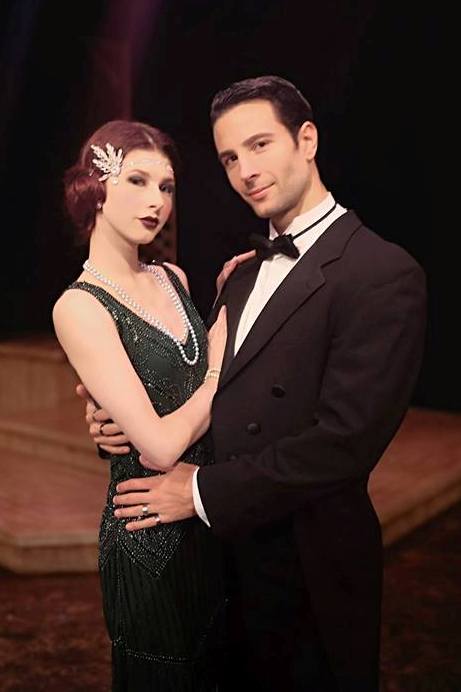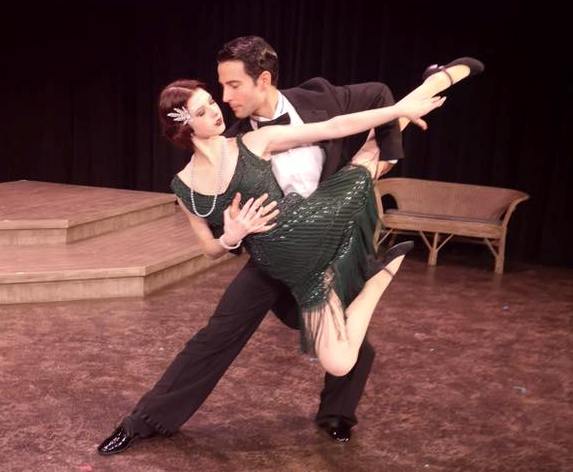The Great Gatsby probes empty American Dream
Posted on December 6, 2018 By Colin MacLean Entertainment, Front Slider, news, Theatre
 As you enter the Walterdale Theatre these nights, there’s a party going on.
As you enter the Walterdale Theatre these nights, there’s a party going on.
There’s music, the clink of glasses and the babble of happy voices. You have stepped into the middle of one of Jay Gatsby’s infamous parties. There’s merriment everywhere – the ladies in their fringed Charleston dresses and the men gussied up in their best soup and fish outfits. What we see is a gaggle of idle party people, and flashy hangers-on drinking and dancing as if there was nothing else to do in all the world.
Walterdale, our scrappy local amateur theatre company, is never one to pale in the face of ambitious projects. Its latest challenge is a stage adaptation of F. Scott Fitzgeralds’s The Great Gatsby. It plays until Dec. 15.
The author’s magnum opus has proven notoriously difficult to adapt. There have been four movies, a couple of television dramas – even an (unsuccessful) opera. The novel, now approaching a century since publication, is regarded as one of the great ones of the 20th Century. The author certainly packed his Roaring Twenties cautionary tale with rich references to decadence, social upheaval, resistance to change and the emptiness of the American Dream.
Playwright Simon Levy’s adaptation centres around narrator Nick Carroway (Simon Pawlowski) who comments on (and participates in) Gatsby’s glitzy jazz-age world of privilege and wealth. The play is set in the playground of the rich and beautiful people who inhabit Long Island in the summer of 1922. Nick is fascinated at the gilded lifestyle he sees – especially that of his rich mysterious next door neighbour Jay Gatsby (Patrick Maloney, handsome in his white suit). But there’s something else about his neighbour that Nick finds: He is the only one who discerns the sad streak that makes Gatsby yearn for the woman he loved and lost.
Nouveau riche, romantic and naive, Gatsby is swimming with the sharks. He may be living the good life but the one woman he loves, the flighty but beautiful Daisy (Melenie Reid), went on to marry another – the churlish and coarse (and rich) Tom Buchanan (Edward Medeiros). Nick feels he must help reunite Jay and Daisy while fielding a romance of his own with Jordan Baker (a lively Kendra Humphrey), a local amateur golfer. As the evening progresses we realize that Daisy is feckless and vapid and not at all the prize Gatsby thinks she is. His relentless pursuit of her will be his undoing.
It is obvious that Walterdale director Bethany Hughes is not going to be able recreate the baroque milieu where Gatsby finds himself. The set is a couple of decorated flats and some furniture, wisely leaving the fabulous mansion of Gatsby entirely to the imagination. But the costumes are spectacular. There are 20 in the cast and they are all opulently tricked out in duds by designer Julieanna Lazowski that certainly capture the time and place.
 Hughes does a commendable job of capturing the mood of the book but Levy doesn’t stray far from Fitzgerald’s text, which means that the narrator speaks mostly in the author’s rich prose. As the narrator, Pawlowski ably bridges the gap between book and stage. Daisy is married to the overbearing bully Tom Buchanan – a menacing, controlling figure. Despite the overtures from Gatsby she can’t seem to pull herself away from her husband. Tom is also engaged in a not-too-secret affair with his lower class girlfriend Mrytle (Samantha VandenBrink). Kosta Lemermeyer as Gatsby’s (probable) Mafia contact, Meyer Wolfsheim, seems to have wandered over from another play (perhaps Guys and Dolls?), but provides desperately needed comic relief.
Hughes does a commendable job of capturing the mood of the book but Levy doesn’t stray far from Fitzgerald’s text, which means that the narrator speaks mostly in the author’s rich prose. As the narrator, Pawlowski ably bridges the gap between book and stage. Daisy is married to the overbearing bully Tom Buchanan – a menacing, controlling figure. Despite the overtures from Gatsby she can’t seem to pull herself away from her husband. Tom is also engaged in a not-too-secret affair with his lower class girlfriend Mrytle (Samantha VandenBrink). Kosta Lemermeyer as Gatsby’s (probable) Mafia contact, Meyer Wolfsheim, seems to have wandered over from another play (perhaps Guys and Dolls?), but provides desperately needed comic relief.
The director’s approach is grand and there’s not a lot of room for humour. Some in the cast are quite good and all make a commendable effort. The play ends operatically (two hours – with intermission), but by then Fitzgerald’s probing of their inauthentic lives leaves you not really caring for any of these empty people.
#TheGreatGatsby #WalterdaleTheatre
READ other reviews of Walterdale shows:
THE TRIANGLE FACTORY FIRE PROJECT – October 2018
NEXT TO NORMAL – July 2018













